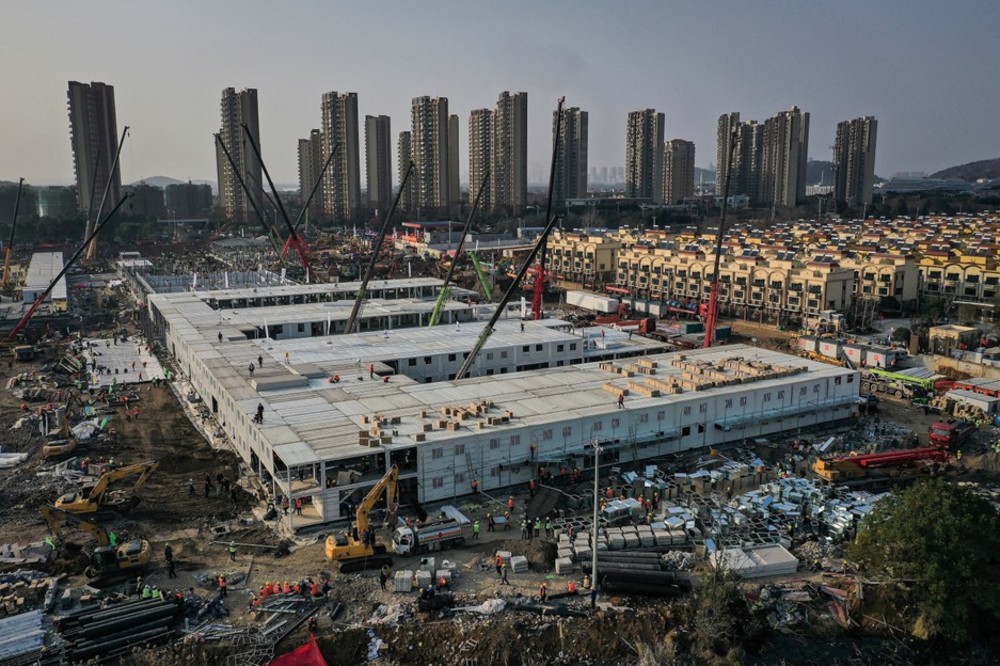This article is part of a blog series exploring how Prefabrication and Modular Construction change the way structures are built. Certain kinds of buildings do, however, lend themselves better to this kind of construction.
Owners who are using prefabrication and modular construction praise its use and know that if they are not the driving force behind these approaches the industry will be reluctant to engage.
What is Prefabrication and Modular Construction?

Modular construction from an owner's perspective
The terms off-site construction or prefabrication are synonyms of modular construction. Owners in modular construction have the possibility to:
- manufacture standard components of a structure in a factory-controlled environment
- assemble and rectify the structure on-site
- re-use the same module in different projects and designs
- change or add a module, without affecting the whole structure
- spend less on capital expenditures.
Pros and cons of modular construction,
Before deciding that modular is the right type of construction, owners consider the following:
- is the design flexible enough?
- can we reduce the cost compared to traditional constructions?
- is customization limited only to a portion of the system, or will it affect the overall system,
- will the module designs be able to interoperable
- will the structure be durable over the construction life cycle?
- will it be possible to personalize the design?
- will the maintenance be easy?
Owners will also have to mitigate the following risks:
- the range of products can be limited
- the planning approval process may prove cumbersome in some cities
- the transportation costs and associated risk may be excessive
- the financing process can be lengthy and difficult.
What are the benefits owners see in modular construction?

The use of prefabrication and modularization has been facilitated by advances in manufacturing methods, construction equipment, information technology tools, and project delivery systems.
Each project is unique and very few are prefabricated today. The prefabrication process implicates the following process:
- prefabricating components
- pre-assembling single systems in the factory
- pre-assembling multi-systems
- assembling all in a volumetric module (4 walls, 1 floor, 1 ceiling)
- shipping them to the site
- assembling the modules on-site
Benefits
When you talk to project owners who have already used this process, they invariably cite the same benefits explained below.
Controlled environment
If you manufacture in a controlled environment your workforce will be more efficient as they can:
- work on better benches and with excellent equipment
- experience good work conditions
- always work from the same location
- enjoy processes designed for them.
Improved productivity
If you repetitively perform the same tasks learning how to perform the work is quick and results in proficiency and productivity.
Fewer labor issues like:
Modular solutions help you to minimize:
- the shortage of trained skilled labor required on-site as you use a different workforce pool to perform prefabricated work
- labor rates.
The ability to compress schedules.
Prefabrication provides a solution that could be completed quickly, as you can do it in parallel with other activities.
Better quality
Modular solutions offer:
- sustainable buildings
- fast and cheap construction
- a better environment for testing or inspecting in a friendlier environment than in the field
- a more consistent quality of finishes
Improved site logistics
You do not have as many people who need bathrooms and break areas.
The fact that a lot of major construction elements happen offsite shrunk the space needs as we go from phase to phase
Increased constructability.
Modelling for constructability at the start of the design phase reduces costly avoidable rework and facilitates better workflow amongst trade contractors.
#### Automation and robotics
Fully automated equipment and robotics are useful for many production systems. They:
- eliminate the variability of labor costs
- mitigate the risks linked with high fixed costs as they can be rented as required. An attractive proposition for a business and legal perspective.
Obviously, construction companies may decide to invest in technology, but in the current economic climate, the volume required to generate a return on investment for the owner will probably not be high enough.
Challenges with using prefabrication and modular.

While the owners agree on the benefits, unique challenges are faced in implementing modular and prefabrication approaches.
In the healthcare and hospitality sector owners find that the supply chain, of prefabrication and modular companies, is still limited. They expect more activity to help solve this issue. Owners also note that contractors need more automation to be more performant.
A healthcare owner mentioned:
If I am building half of the building off-site, I have half the amount of people on-site and all the overhead associated with those folks. That cost is not accommodated in the prefab model.
A residential owner notes that the financing sector still needs to understand better this mode of construction. He is part of a group designing guidelines on what to expect from these kinds of projects.
An education owner finds that there is a trade-off in terms of the limitations of the modular model. You must work within its parameters.
Getting designers to change their processes to design for prefabrication has also been challenging for most of the owners we talked to.
The decision-making process for going modular.

Owners drive the use of these approaches. Selecting prefabrication vs. traditional site construction methodologies is complex and based on various factors:
- site circumstances
- skilled staff accessibility
- transportation environment
- owners’ readiness
- local laws
- project schedule and budget
- sustainability requirements
- design complexity.
The key to prefabrication is to acquire early feedback from specialty subcontractors.
Feedback focuses on the ability to achieve:
- tolerances
- delivery times
- equipment availability
- repetitiveness.
Evaluating alternative schemes for stick-built and modular-built aspects of the project will help you narrow it down to one solution.
Major prefabrication details in terms of systems and sizes are isolated through early design routines and iterative parametric studies.
The studies on modules are designed under the drive of the owner so he can support these approaches and their associated details. Once alternatives are chosen, constructability reviews, preliminary sequencing, and code reviews can be conducted to help select the best alternatives. These alternatives are then compared to the other systems to narrow down the ideas to the single best solution to be fully designed.
Constructability, site logistics, and planning for fabrication and construction should be formulated to make sure the design meets the appropriate construction requirements.
The parameters will determine what material is available and its associated limitations.
Fabrication inherently implies manufacturing of components, elements, and assemblies to a certain level before they are shipped to the site for final assembly (construction).
Within fabrication there are two primary core ideas, they are:
- planning the production in the factory and
- the actual production of the modular unit.
The production line for making the units can take three directions:
- all hand assembly (human workforce)
- fully automated (machine workforce only)
- a hybrid of 1 and 2.
Depending on the modular units and available automated machinery, the third option is most likely.
Once the modular unit or assembly is finished within the factory, then the construction phase starts.
A major advantage of modular construction is that it takes most of the production and time away from the construction site which is often the slow unproductive activities in construction.
On-site placement of modules reduces the high variability in how different structural types could be constructed.
Construction starts with an adjustment to the structural schedule for any delays or conditions that appear on-site or issues that occurred at the factory and were not previously accounted for.
The first construction task is the erection of any supporting structure that will be used to support the module(s).
Often, these are lateral systems and possibly even floor/diaphragm systems. At the same time, foundations need to be constructed.
Once constructed, the modular units can be set into place and attached/connected to other building support systems.
Let’s have a look at 2 examples of modular construction to better understand this concept.
Examples of Modular constructions

Picture of Nakagin Capsule Tower
Architect: Kisho Kurokawa.
The Nagakin Capsule Tower is the first example of capsule architecture designed to house traveling businessmen who worked in Central Tokyo.
The design includes:
- 140 capsules stacked and rotated at various angles around a central core
- each capsule, measuring 100 sqft, offers enough room for one person to live comfortably
- every module can be plugged into the central core and replaced or exchanged when necessary.
The structure is an example of the modular construction of the future and how to achieve sustainability and recyclability.
Wuhan Hospital
Architect: nArchitects
The Wuhan 1000-bed hospital was built in February 2020 during the COVID-19 pandemic it is an example of:
- how to use modular in times of emergency and crisis
- how to build a hospital in 2 weeks
- how to isolate and treat COVID-19 patients.
In Conclusion

Picture of Wuhan Hospital
The owners in the Construction Industry agree that both refabrication and modular construction can:
- improve safety and quality
- reduce costs and schedules
- enhance sustainability performances
- mitigate the risks of workforce shortages, supply chain uncertainties, and other challenges.
Prefabrication and pre-assembly are valuable methods to
- speedup schedule
- augment the value added to customers for lower prices.
Understanding how prefabrication can benefit the project business case and its value proposition early on can help owners establish an adequate procurement strategy.
Driving Vision's technology appraisal looks at the best way to insert new technology in your workflows and how to move your organization to cloud computing so you can open new possibilities for your daily planning tasks and make sure your data never leaves the optimally secured data center.
A Driving Vision expert will conduct the interviews online and will discuss with you the report and our findings. Together we will decide the best way to implement the solutions at your pace and according to your budget.
Implementing BIM can be daunting, but Driving Vision is here to help you at the pace you are comfortable with. Get started by getting in touch now








